
There are those days I regret not having a summer blooming perennial garden. The big and wild kind. Russian Sage, hyssop, shrub roses, hardy hibiscus, monarda-I am sure you know what I mean. I am not a fan of rudbeckia, so I plant hemerocallis “Goldner’s Bouquet” in any perennial garden I design. -It is a clear yellow that blooms late and blooms heavily; I would guess a mature plant has a 300plus bud count. It was bred by our noted landscape designer Al Goldner. He hybridized in the field, without supplemental irrigation; he loved any perennial that had the staying power of a shrub. It is no doubt the finest daylily I have ever had the pleasure to plant. But I am ahead of myself-let’s go inside a landscape of mine, with a fine summer garden.
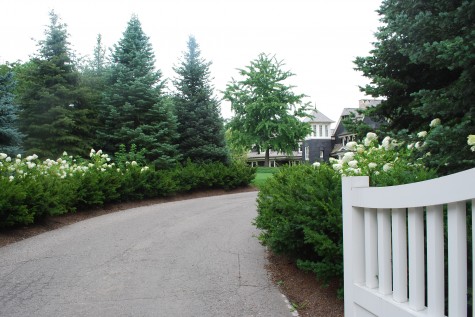 The entrance to the property has a beautiful view-in large part sparked by my client. Designers who do not listen to their clients miss plenty. I did design the drive especially to court the view; my client went over this plan again and again, until we both were happy with it.
The entrance to the property has a beautiful view-in large part sparked by my client. Designers who do not listen to their clients miss plenty. I did design the drive especially to court the view; my client went over this plan again and again, until we both were happy with it.
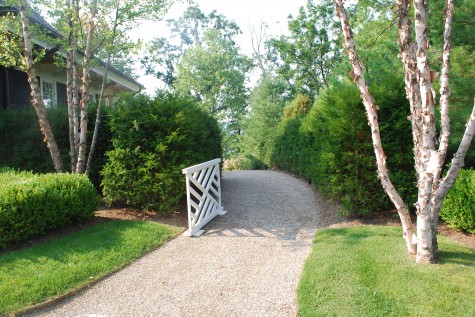 A decomposed granite walk leads to the rear yard; the gate is still in the design phase. A good walk intrigues a visitor. Vis a vis the curves in this walk-what need is there to telegraph every move a landscape makes from the start? A well designed walk anticipates interest, before the landscape delivers.
A decomposed granite walk leads to the rear yard; the gate is still in the design phase. A good walk intrigues a visitor. Vis a vis the curves in this walk-what need is there to telegraph every move a landscape makes from the start? A well designed walk anticipates interest, before the landscape delivers.
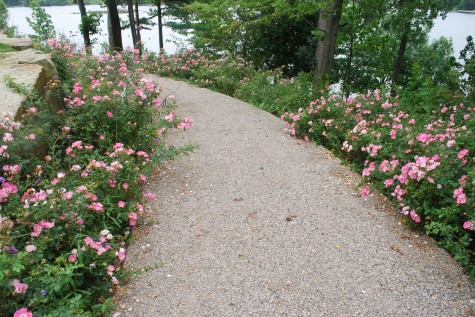 This long walk to the rear is fringed by the Griffith Buck rose, Carefree Delight. No kidding, a carefree wonder. This rose blooms and grows profusely, with little or no disease, in full sun, or part shade. This hedge performs equally, in spite of differing sun conditions, and fierce winter winds off the lake. I know a planting of them near me done by a friend-some 12 years old. Gorgeous. Carefree Beauty is my favorite rose; Carefree Delight delivers spectacularly; it is everblooming, adaptable to less than optimal siting, and happy to boot.
This long walk to the rear is fringed by the Griffith Buck rose, Carefree Delight. No kidding, a carefree wonder. This rose blooms and grows profusely, with little or no disease, in full sun, or part shade. This hedge performs equally, in spite of differing sun conditions, and fierce winter winds off the lake. I know a planting of them near me done by a friend-some 12 years old. Gorgeous. Carefree Beauty is my favorite rose; Carefree Delight delivers spectacularly; it is everblooming, adaptable to less than optimal siting, and happy to boot.
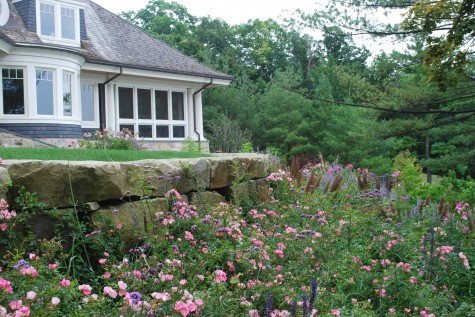
The hedges of Carefree Wonder roses give way to a perennial garden that slopes towards the lake from the house.
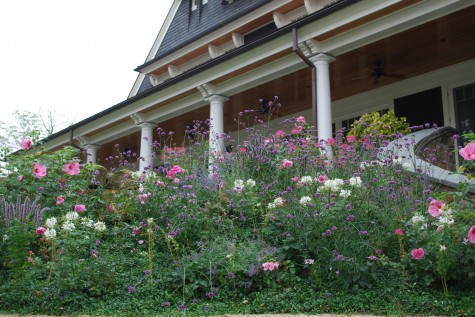 This wild summer garden is in remarkable contrast to the architecture of the house. It is, to my mind, a successful relationship. At the risk of repeating myself, I think the dynamics of a relationship far outweigh this part, or that part-taken individually.
This wild summer garden is in remarkable contrast to the architecture of the house. It is, to my mind, a successful relationship. At the risk of repeating myself, I think the dynamics of a relationship far outweigh this part, or that part-taken individually.
This aforementioned perennial garden faces down the lake. Spot gardens on the way to the lake repeat the idea- big gorgeous house skirted beautifully with a big wild garden. This landscape is three years old, and growing.
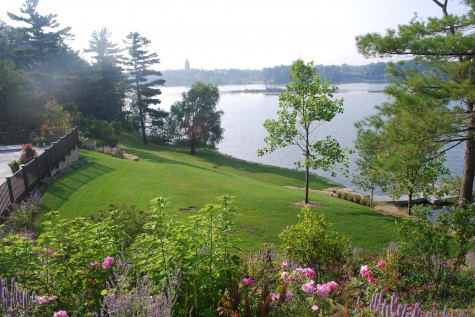
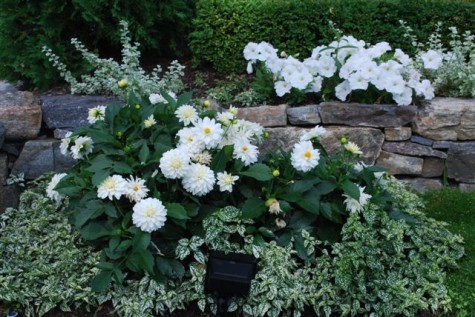
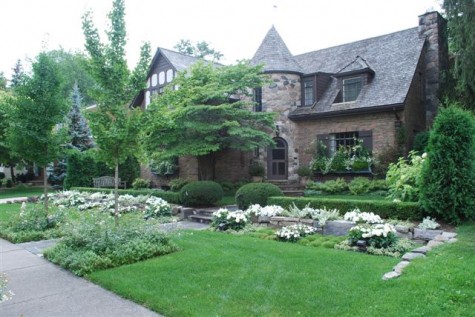 These clients have lived many years in a lovely old Tudor style house built in the 1920’s. However, they both have a love for clean, modern and edited lines. Working with them has produced a garden that has elements both friendly to the architecture of the house, and their point of view. They were both clear that a green and white garden would suit them best.
These clients have lived many years in a lovely old Tudor style house built in the 1920’s. However, they both have a love for clean, modern and edited lines. Working with them has produced a garden that has elements both friendly to the architecture of the house, and their point of view. They were both clear that a green and white garden would suit them best. 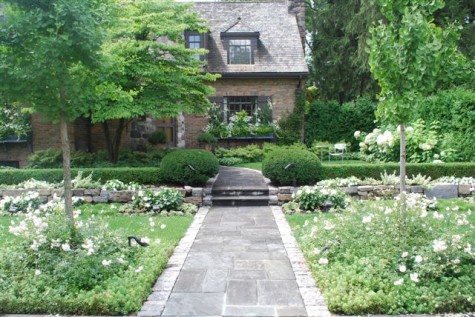 The landscape of the front of the house was already in place when I met them. My input involved the sizes of the flower beds, and the construction and installation of the window boxes. The profusion of flowers is decidedly English in feeling, but the green and white has a crisply contemporary flavor. The strong, dark green horizontal line of the boxwood hedge contrasts and compliments the mass of the oval yews. This element is balanced by the four columnar gingkos that frame the walk at the street. The simple steel windowbox is a focal point at the visual end of the walk.
The landscape of the front of the house was already in place when I met them. My input involved the sizes of the flower beds, and the construction and installation of the window boxes. The profusion of flowers is decidedly English in feeling, but the green and white has a crisply contemporary flavor. The strong, dark green horizontal line of the boxwood hedge contrasts and compliments the mass of the oval yews. This element is balanced by the four columnar gingkos that frame the walk at the street. The simple steel windowbox is a focal point at the visual end of the walk. 
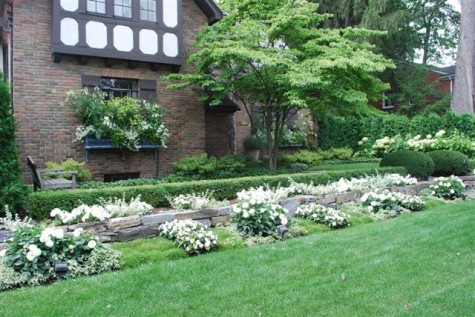 The upper level is planted more freely, with variegated licorice, white petunias and more polka dots. This bedding plant scheme derives more visual interest from its texture and layout than from the plant species.
The upper level is planted more freely, with variegated licorice, white petunias and more polka dots. This bedding plant scheme derives more visual interest from its texture and layout than from the plant species.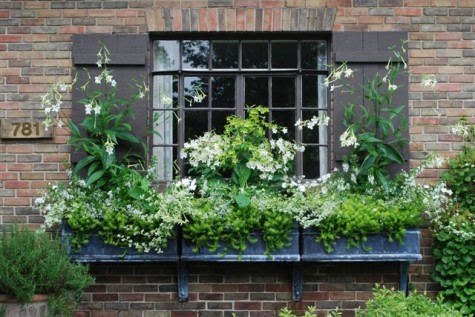 The window boxes are lush with green angelina, euphorbia, and licorice. The angular nicotiana alata white frames the more orderly growing Perfume nicotiana series in white and lime green.
The window boxes are lush with green angelina, euphorbia, and licorice. The angular nicotiana alata white frames the more orderly growing Perfume nicotiana series in white and lime green.
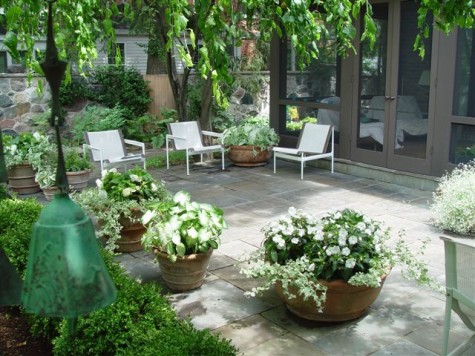
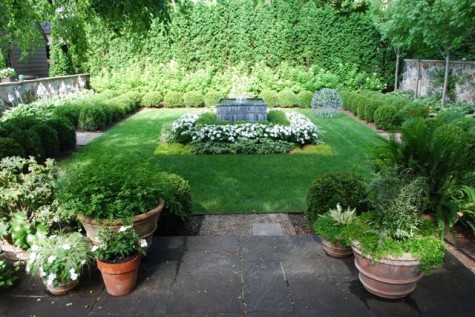 A custom made steel cistern positioned on axis to the porch, and the side walk organizes the space. It was constructed with legs tall enough to hide the fountain pump, but also to provide for the eventual height of the boxwood surrounding it. Bordered in boxwood, a run of limelight hydrangeas provides another level of interest against the green arborvitae wall.
A custom made steel cistern positioned on axis to the porch, and the side walk organizes the space. It was constructed with legs tall enough to hide the fountain pump, but also to provide for the eventual height of the boxwood surrounding it. Bordered in boxwood, a run of limelight hydrangeas provides another level of interest against the green arborvitae wall.
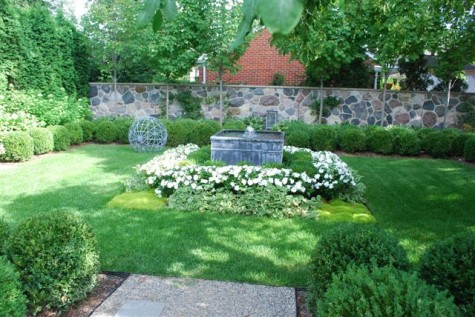
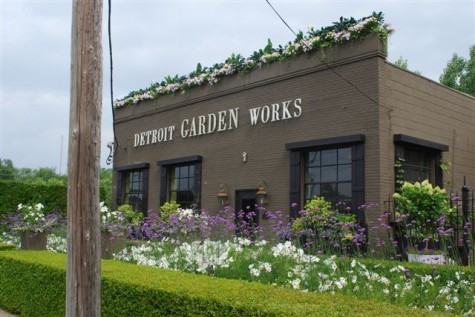 Every year I plant the front of the store differently; this year I wanted the planting to feel like a meadow. The big bed of violet colored verbena bonariensis and white cosmos is almost always in motion. The marguerite daisies and petunias in the roof boxes are thriving, sheltered by a hedge of Nero di Toscano kale that will be the star of the show by fall. The kale does for the daisies what the boxwood does for the verbena; their respective relationships are good ones.
Every year I plant the front of the store differently; this year I wanted the planting to feel like a meadow. The big bed of violet colored verbena bonariensis and white cosmos is almost always in motion. The marguerite daisies and petunias in the roof boxes are thriving, sheltered by a hedge of Nero di Toscano kale that will be the star of the show by fall. The kale does for the daisies what the boxwood does for the verbena; their respective relationships are good ones.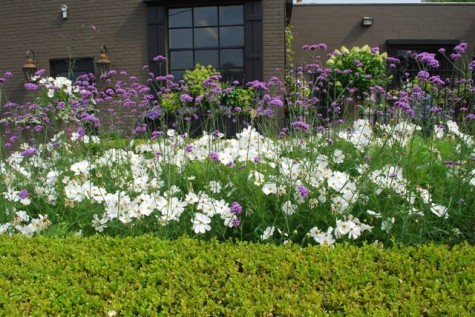

 However, as any gardener knows, nature never sits. Someone once put it to me like so-nature abhors a vacuum. So this property is in phase one of its ecological evolution; disturbed ground is first colonized by grasses and other tenacious and vigorous plants, popularly known as weeds.
However, as any gardener knows, nature never sits. Someone once put it to me like so-nature abhors a vacuum. So this property is in phase one of its ecological evolution; disturbed ground is first colonized by grasses and other tenacious and vigorous plants, popularly known as weeds.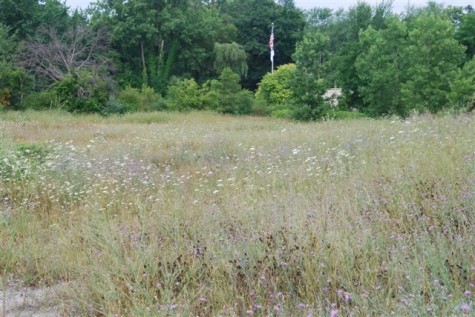
 Queen Anne’s Lace is one of my favorite flowers. I buy bunches of it at market this time of year. Its tap-rooted vigor makes it a poor choice for a cultivated garden, but it vastly dignifies the look of vacant lots like this one. Its more civilized cousin, amni majus, can be grown in a garden to great effect; it is grown routinely for the cut flower trade. However, I am perfectly happy with this distant and unruly relative.
Queen Anne’s Lace is one of my favorite flowers. I buy bunches of it at market this time of year. Its tap-rooted vigor makes it a poor choice for a cultivated garden, but it vastly dignifies the look of vacant lots like this one. Its more civilized cousin, amni majus, can be grown in a garden to great effect; it is grown routinely for the cut flower trade. However, I am perfectly happy with this distant and unruly relative.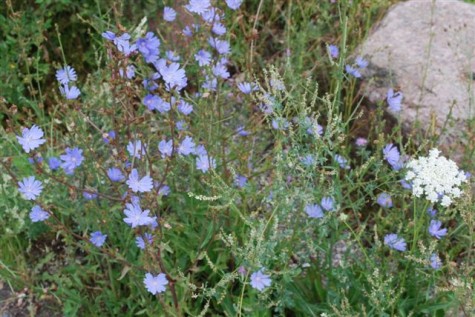 Chicory is the devil to get rid of; it is perfectly capable of worming its way through a crack in a concrete road. It is the most beautiful blue, a color not often seen in Michigan gardens.
Chicory is the devil to get rid of; it is perfectly capable of worming its way through a crack in a concrete road. It is the most beautiful blue, a color not often seen in Michigan gardens.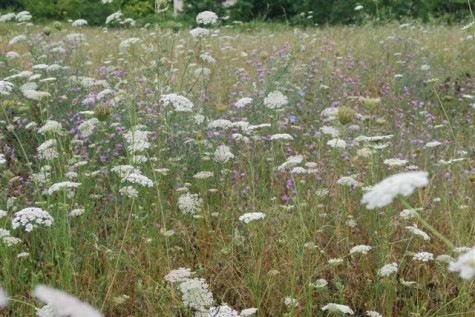 The mix of colors, the uniformly wispy textures, the motion of it all – breathtaking. There are garden flowers that have a meadow-like habit-panic grass, hyssop, bee balm, boltonia and so on-but there is no scripted garden that looks quite like this one.
The mix of colors, the uniformly wispy textures, the motion of it all – breathtaking. There are garden flowers that have a meadow-like habit-panic grass, hyssop, bee balm, boltonia and so on-but there is no scripted garden that looks quite like this one.

 The burnt orange/carmine and chartreuse leaf of the coleus “Freckles” is a study in color contrast in and of itself. The orange impatiens does a good job of the harmony for this tune.
The burnt orange/carmine and chartreuse leaf of the coleus “Freckles” is a study in color contrast in and of itself. The orange impatiens does a good job of the harmony for this tune. Every year I grow nicotiana alata lime. The color of the flower takes on a different aura, when paired with other colors. With other greens the flowers are soft and subtle. A little pale carmine in the coleus leaf, and pilea, is an echo, not a trumpet blast.
Every year I grow nicotiana alata lime. The color of the flower takes on a different aura, when paired with other colors. With other greens the flowers are soft and subtle. A little pale carmine in the coleus leaf, and pilea, is an echo, not a trumpet blast.
 I am having a carmine and orange season, and enjoying it immensely. Carmine alone sometimes has the effect of setting one’s teeth on edge; the addition of the orange makes for a very warm pleasing glow. When I get home in the evening, the overcast light makes all the color appear even more saturated. The design idea here-figure out what time of day you will be in your garden, or what time of day you best like to be in your garden. You’ll have an idea of what the light will be; choose your color accordingly.
I am having a carmine and orange season, and enjoying it immensely. Carmine alone sometimes has the effect of setting one’s teeth on edge; the addition of the orange makes for a very warm pleasing glow. When I get home in the evening, the overcast light makes all the color appear even more saturated. The design idea here-figure out what time of day you will be in your garden, or what time of day you best like to be in your garden. You’ll have an idea of what the light will be; choose your color accordingly.
 I like here the relationship of the green to the orange. Zesty!
I like here the relationship of the green to the orange. Zesty! Lime and carmine together I simply find appealing-all understanding of the science of color aside. The color of live flowers or plants-they call this a special kind of color-living color. I wouldn’t be without it.
Lime and carmine together I simply find appealing-all understanding of the science of color aside. The color of live flowers or plants-they call this a special kind of color-living color. I wouldn’t be without it.